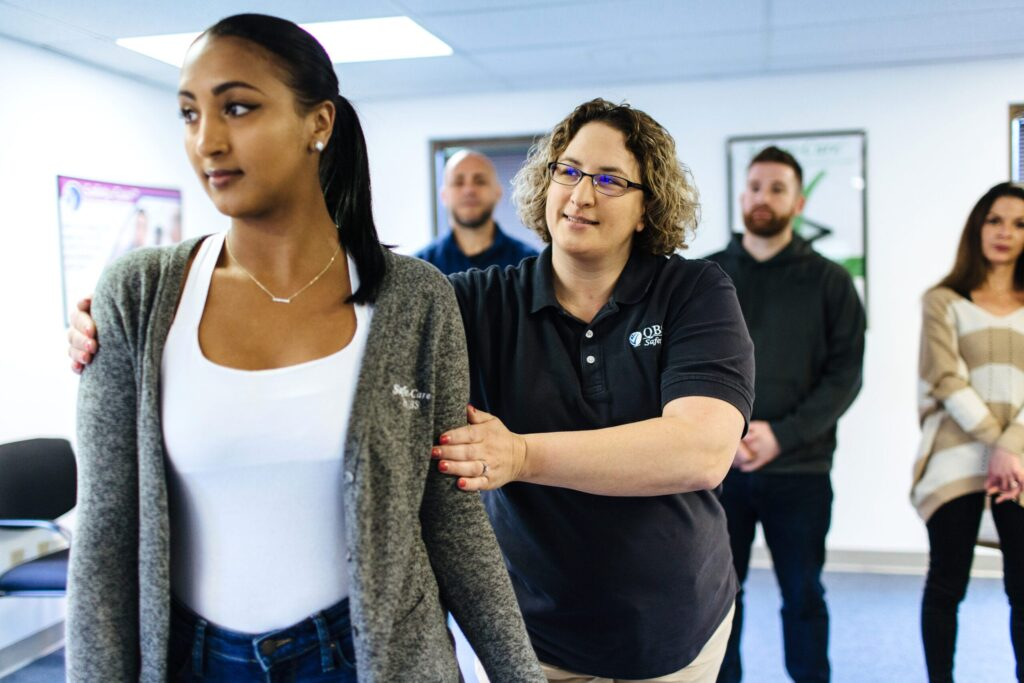Ohio ADC – Positive Behavior Intervention Supports and Use of Restraint and Seclusion
As of June of 2021, staff in Ohio schools are required to receive training in Positive Behavior Intervention Supports. Additionally, new limits were placed on the use of restraint and seclusion. Below is a summary of these requirements as well as information on how Safety-Care can be used to ensure the safety of all staff and students.

.png?width=88&height=95&name=Group%20137%20(5).png)


How to Implement Safety-Care?
1. Register for a Safety-Care Trainer class or call us to request a closed session for your organization. We regularly conduct classes in all 50 states and Canada.
2. Complete your class to become a certified Safety-Care Trainer for your organization. We bring you to fluency using an errorless teaching methodology.
3. You train and certify your staff in Safety-Care’s effective techniques.
4. Our Master Trainers are available by phone, email, or video to help your organization with any questions or concerns while using or implementing Safety-Care.

Legal Requirements
|
Summary: Effective: June 24, 2021 Last Updated: December, 2024 As of June of 2021, staff in Ohio schools are required to receive training in Positive Behavior Intervention Supports. Additionally, new limits were placed on the use of restraint and seclusion. Below is a summary of these requirements as well as information on how Safety-Care can be used to ensure the safety of all staff and students. How Safety-Care aligns: Numerous education organizations throughout the United States and Canada rely upon QBS and our Safety-Care training to provide their staff members with the training they need to help maintain a safe and healthy environment. Safety-Care provides a comprehensive, supportive approach to incident prevention, de-escalation, and management. Your Staff will learn practical strategies for helping students that use evidence-based practices consistent with PBIS (Positive Behavior Interventions and Supports) and ABA (Applied Behavior Analysis). |
|
3 OH ADC 3301-35-15 (D) General rules for restraint and seclusion. (1) The following practices are prohibited by student personnel under any circumstance:
How Safety-Care aligns: While Safety-Care does teach numerous physical safety procedures, the focus of our program is on de-escalation and positive behavior reinforcement. intervention strategy. Our approach stems from the use of Positive Behavior Intervention and Supports (PBIS) that can prevent and manage challenge behavior. Safety-Care certified individuals are trained to use our Help, Prompt, and Wait strategies as early intervention procedures that effectively de-escalate potential crisis situations before any physical management is necessary. (2) A school district may only use physical restraint or seclusion if staff:
|
|
(E) Physical restraint. (1) Prone restraint, including any physical restraint that obstructs the airway of the student, or any physical restraint that impacts a student’s primary mode of communication, is prohibited. A statement to this effect is to be included in the school district’s policy. Student personnel may use physical restraint only as a last resort and in accordance with local policy and the requirements of this rule. (2) Physical restraint may be used only:
(3) Physical restraint may not be used for punishment or discipline or as a substitute for other less restrictive means of assisting a student in regaining control. How Safety-Care aligns: Safety-Care promotes the use of de-escalation prior to the use of any physical management. Physical management techniques are designed to ensure the safety of all participants and are only to be used until the situation has de-escalated. Safety-Care can be designed and taught to match local requirements regarding restraint but always focuses on the least restrictive and safest methods. All physical management techniques are role-played by trainees to ensure that they fully grasp the need for minimum restriction and full safety of all participants. Our Master Trainers verify each trainees use of these techniques in role-play, further ensuring their safe use. Each trainee must prove mastery of proper technique use before they can be certified in Safety-Care. Safety-Care prohibits the use of chemical restraints. |
|
(H) Training and professional development for the use of crisis management and de-escalation techniques which includes the use of restraint and seclusion. (1) A school district shall ensure that an appropriate number of personnel in each building are trained annually in evidence-based crisis management and de-escalation techniques, as well as the safe use of physical restraint and seclusion. The minimum training requirements are as follows:
How Safety-Care aligns: Safety-Care uses a Train the Trainer model allowing each district to quickly develop their own core of trainers qualified in the most current behavioral interventions and de-escalation strategies. Our Master Trainers can have up to ten (10) staff ready to train in as little as three days. Safety-Care is uniquely designed to provide trainees with the skills to assess potential crises, how de-escalate these situations, and how to respond if the situation is elevated. Our trainings are trauma-informed and focus on modifying behavior to prevent dangerous outcomes. Safety-Care is focused on encouraging positive behavior prior to the use of any other intervention strategy. Our approach stems from the use of Positive Behavior Intervention and Supports (PBIS) that can prevent and manage challenge behavior. Safety-Care certified individuals are trained to use our Help, Prompt, and Wait strategies as early intervention procedures that effectively de-escalate potential crisis situations before any physical management is necessary. Safety-Care can be taught to all levels of school personnel, from administration down to volunteers. Additionally, our core trainings can be supplemented with unique add-on trainings focused on specific needs and professions. Safety-Care is geared towards ensuring that all trainees are familiar with a single response system and can respond in-kind to numerous situations regardless of the professional setting. |
Why Safety-Care?
Benefits & Differentiators
In addition to Safety-Care being highly cost-effective, you get:

Skills to effectively prevent, minimize, & manage behavioral challenges with dignity, safety, & the possibility of change

Decreases in staff and patient injuries and reduction in restraint & seclusion time

Instructional procedures based on decades of evidence-based research & compatible with ABA, PBIS & reinforcement-based environments

Customizable program for your setting, staff & clientele, with a strong focus on preventative via non-intrusive, replacement behaviors

Extremely rigorous standards grounded in errorless teaching methodology

Small, intimate class sizes backed by unlimited support & resources
How Is Safety-Care So Effective?
A Genuine Focus on Implementing & Managing Positive Behavioral Skills
Proactive, environmental management recommendations
Understanding of evocative effects of staff behavior
In-depth analysis of antecedents and proactive antecedent interventions
Evidence-based reinforcement procedures
Required competency in de-escalation skills
Humane, non-invasive touch and QBS Check™ strategies
Evidence-based teaching procedures
Applicable to a wide array of settings, conditions & challenging behavior





